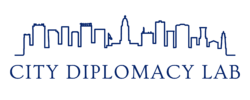-
Olympic Cities: Sustainable Visions and Legacies

For a long time, the Summer and Winter Olympic and Paralympic Games have been a source of competition among candidate cities. In recent years, however, a new question has become the priority: how can hosting the Olympics contribute to a city’s sustainable development? Indeed, the Olympic and Paralympic Games have become catalysts of sustainable urban transformations that, once implemented in host cities, can be replicated elsewhere.
This conference will focus on this trend from the angle of Paris, Los Angeles, Milan, and Brisbane – the current and future Olympic and Paralympic host cities.
Date: September 6, 2024, at 9:30 AM CEST
Language: English
This event is co-organized by City Diplomacy Lab, the Columbia Global Paris Center, the U.S. Embassy in Paris, and the United Nations Environment Program.
-
Towards inclusive (smart) city diplomacy in Africa. Lessons learned from the ASToN Network

European cities — and municipalities from developed countries, more widely — have at their disposal a plethora of opportunities to network, learn from one another, and share their experience and views at the global level. Which place, though, for the cities from the Global South, in the field of city diplomacy, once we leave the capital or the charismatic cities out? This is one of the questions the ASToN program tried to answer, looking at how African cities can be in the driver’s seat in both their digital transition and international action by joining a group of peers for three years.
By Simina Lazar
African cities are among the youngest and fastest growing in the world. While numbers vary, Lagos (Nigeria) alone is said to welcome 4000 new persons every day who are looking for better living conditions in the metropolis. Like everywhere else, this demographic increase puts enormous pressure on the infrastructure, housing, and job opportunities available, not to mention on the public services and the development of the informal market. At the same time, this presents an opportunity to do things differently, tap into Africa’s innovation and creativity, and link it with potential technology offerings by bringing people together to discuss solutions and ways forward.
Despite their energy, innovation, and creativity, African cities are not yet fully present at the table of global discussions. For example, the 2022 UN-Habitat Global Review of Smart City Governance Practice only saw 14 African out of 250 cities replying to the survey. So how can African cities make their voices heard beyond their borders when internet cuts, staff shortages or dealing with emergencies is their daily routine? While continental, ambitious initiatives are still rare and financial resources are often scarce, African city leaders can bring their unique perspectives and challenges to the international table of discussions. Here are the main lessons from the ASToN (African Smart Towns Network) program that, from 2019 to 2022, assembled 11 African cities on an experimental learning journey. The program was financed by the French Development Agency (AFD) and used URBACT methods and tools.

Building a community of practitioners across 11 African countries…
ASToN focused on the unique digital challenges brought by the cities and on the humans that represented them. By testing, learning, and iterating, a program journey was designed that was adaptive and responsive to the needs of cities. It offered a regular rhythm and balance, bringing in technical expertise and city experience. Fully aware that our initiative is a one-off, our ambition was also to create a community of people that would outlive the program.
While we were aware that the digital maturity of both institutions and the territory was variable across the network, little did we know about the cities’ previous exposure to international programs or their representatives’ participation in somewhat similar initiatives. Here again, we found a gradient of situations, from Kampala (Uganda) or Niamey (Niger) leaders, used to taking the floor in international conferences and gatherings, to Sèmè Podji (Benin) or Matola (Mozambique) representatives who were joining an international group of peers for the first time. The challenges they were confronted with are similar to many other city leaders around the world: initiatives like ours came on top of already very heavy workloads, internal procedures and hierarchy were often incompatible with the lean approach our program required, and their administrations often faced important turnovers. So, how do you build a network of peers in such a context, and more importantly, how do you make it last beyond the program’s life?

Field visit during Kigali all-partner meeting (Nov 2021) Through ASToN, we tried as much as possible to create a community and sense of collective identity and belonging between participating cities. Our assumption was that these relationships would outlive the network and spark more opportunities than we could imagine. The community can boost any other types of support that might be offered by program activities, as it allows people to take the lead and ask for what they need from one another directly[1]. Making change and doing things in new ways in a city authority can be hard. We thus designed settings that allowed city representatives to provide their counterparts with support and guidance based on their deep technical expertise and previous experiences. With turbulences like changing politics or external shocks, we also realized there could be a strong sense of peer support for when progress is hard – a feeling of being ‘in it together.’
The Agile approach that was proposed to cities to develop their digital solutions at the local level was also used as a wider framework for network activities. From the start, our commitment was to keep things moving while also being ready to close things down when needed. In doing this, we built coalitions of relevant partners who could support and inspire participating cities by organizing small thematic groups around mobility, e-tax, or land management, some of the main sub-themes of the network. We were also mindful of the fact that different cities were moving at different paces. Unforeseen shocks like the pandemics, social movements such as the 2020 Lagos #endSARS riots, or natural disasters such as the flooding that hit Niamey in early 2021 meant that some cities were absent from group activities for certain periods. Nonetheless, when able to do so, they all came back, proving how relevant the network was for them.

ASToN session at the World Urban Forum (June 2022) …and providing a platform
A key priority for ASToN from the start was communication, and it became crucial when the pandemic hit. By developing several strategic partnerships with Civic Tech Innovation Network, the UN-Habitat People-Centered Smart Cities program, or Bloomberg’s network of Chief Innovation Officers, ASToN city leaders participated in several high-level discussions. Several ASToN cities, like Bizerte (Tunisia) or Kumasi (Ghana), continue to be invited every year to such events as the Smart City Expo, speaking out not just for themselves but for their fellow African partners. Sèmè Podji joined in 2023, together with several French local authorities, a cooperation program led by PFVT focusing on digital transitions, directly contributing to the UN-Habitat Smart Cities resolution. For example, some city leaders from Nouakchott (Mauritania) decided to take on more formal training by enrolling in Master’s degrees in urban planning, smart cities, or digital transitions rolled out by African Universities.
We are also aware that the space for cooperation and exchange is closing in some parts of the world, and the possibility that some cities will have to exchange and learn beyond their borders is no longer possible today. This is the case for Niamey or Bamako (Mali), where different political visions, as well as endemic electricity shortages, make impossible the kind of work an international program requires.

The Bizerte team testing the city cleanliness solution with truck drivers. What money can and cannot buy
What about the lessons learned from investing nearly 3M€ in a one-off program like ASToN? Despite the challenges encountered along the way, 9 out of the 11 cities ran pilot phases, and all of them designed digital solutions for the challenges they had identified. We organized several pitching sessions where cities presented their solutions to potential partners and investors. Nonetheless, the opportunities they were offered remained limited in comparison with what is possible for their European counterparts. If some cities advanced in developing their solutions, like Benguerir’s (Morocco) app or Kampala’s mobility solution, this was done through internal funding. For others, like Bizerte, ASToN proved to be the stepping-stone for the city to join several national initiatives, acting as a pilot case for implementing a digital one-stop shop for citizens or developing an online Services Kiosque. These are, of course, important spillover effects from an experimental initiative like ours. However, they also show the extent to which African cities are still on the receiving end, integrating investor or donor programs coming from above rather than negotiating international finance to push their strategies ahead.
The Blueprint for Running a City-to-City Cooperation Program contains all the lessons learned from designing and running ASToN, from the practical to the more strategic. It also presents tools and tips for carefully designing the onboarding method or the support and grant funding mechanism, in addition to some other points that I raised in this article.
For policymakers who are considering building such initiatives, there is one more thing I can add today, more than a year after the program ended. ASToN’s unique proposition also proved its weakness. Back in 2019, we were the only network dedicated exclusively to African cities, providing tools and resources for both local activities and network interaction. Thinking in detail about what comes after, which are the exit strategies both for cities and the program as a whole, must be at the core of such experimental programs to build lasting results. While the community continues to exist and bilateral relations grow, more resources and support are needed for African cities to bring their voice to those discussion tables where what tomorrow is made of will be decided.
[1] In the Secretariat, we would do a victory dance every time we heard about cities working together or asking for advice from one another, outside ASToN’s official communication channels.
Header image: field visit during the Kigali all-partner meeting in November 2021.
-
Fostering inclusive nature-based solutions in cities across the world

The loss of nature and biodiversity due to urbanization and climate change has serious consequences for cities and the well-being of their residents. This is most evident in disasters like floods, heat waves, and smog, which disproportionately affect low-income and marginalized communities.
This second episode of the Urban Innovation to Achieve Just & Sustainable Cities series will focus on how working with nature within and around cities can protect vulnerable and low-income urban residents from climate change impacts and disasters, improve their quality of life, and reduce cities’ impacts on other valuable systems.
This session is co-organized by Deutsche Gesellschaft für Internationale Zusammenarbeit (GIZ) and ICLEI in partnership with Cities Alliance, UN-Habitat, Slum Dwellers International, the Centre for Affordable Housing Finance, the African Union for Housing Finance, and the City Diplomacy Lab.
In continuity with the March kick-off event on “Fostering sustainable construction in informal urban areas”, this virtual event brings together a diverse group of experts and practitioners to engage in constructive dialogue on the development of sustainable urban planning, construction, and financing strategies for cities across the globe.
Keynote: Anna Heringer, Architect
Panelists :
- Jaqueline Mueni Katu, Senior Environment Officer, County Government of Kisumu
- Ashali Bhandari, Managing Director, People’s Urban Living Lab, Transitions Research
- Julie Greenwalt, Senior Climate Advisor, Cities Alliance
Moderator: Lorenzo Kihlgren Grandi, City Diplomacy Lab
🗓 Thursday, June 27, 2024, 1:00-2:30 P.M. CEST/UTC+2
🗣 Language: English, with written translation in French and Spanish.
Watch the recording
-
UNESCO Cities of Media Arts explore the latest frontiers of digital creativity

This year’s International Biennial of Media Arts (Bains Numériques) hosted by the French city of Enghien-les-Bains focused on the role of digital creativity in building more sustainable urban communities.
The local Centre des Arts (CDA95) partnered up with the City Diplomacy Lab and the French National Research Agency (ANR) to deliver a rich program featuring over 20 events. UNESCO Creative Cities representatives, scholars, and artists offered the public a unique insight into today’s urban transformations and the upcoming urban future.
Highlights

More and more cities worldwide are operating as workshops for participative, innovative, and concrete solutions to today’s major challenges, such as climate change, growing inequalities, and security. City Diplomacy Lab Director Lorenzo Kihlgren Grandi explored the impact and scope of the growing interconnection between these local practices and the emergence of city diplomacy focused on creativity and innovation.
Hiroyuki Suzuki and Makiko Tatsumi presented the Kyoto Arts and Technology Village, a new and innovative space created through a partnership between the Centre des Arts, Kyoto Prefecture, and the Advanced Telecommunications Research Institute International (ATR). They offered insight into this space’s unique strategy of fostering the connection between art and technology within emerging industries.


Representatives of Campina Grande, Namur, and Novi Sad – three UNESCO Creative Cities of Media Arts – shared their experiences and vision of international city-to-city cooperation. This panel offered insight into the shift from a one-way assistance logic to an approach based on a partnership between peers for common goals, in line with the United Nations Agenda 2030.
Gwangju, known as Korea’s City of Light, joined the UNESCO Creative Cities Network in 2014. The city’s commitment to creativity is symbolized by the creation of the Gwangju Media Art Platform (G.MAP), whose task is to “draw of Gwangju’s future with media art.” G.MAP Director Lee Kyungho presented his city’s cultural ecosystem and discussed the role of the new center in making Gwangju a “city of the future.”

The International Biennial of Media Arts was an in-person-only event with English-French simultaneous translation. Free participation upon registration.
-
Exploring the future of city diplomacy in Bogotá

On May 16, 2024, the City of Bogotá, a City Diplomacy Lab Advisory Board Member, hosted a global conference to discuss the future of city diplomacy with experts and practitioners from across the world.
Over the last few years, Bogotá has become a beacon of city diplomacy worldwide, as symbolized by the appointment of former Mayor Claudia López as UN-Habitat Ambassador for the New Urban Agenda and Metropolis President.
As new Mayor Carlos Fernando Galán assumed office in January 2024, he further upgraded the relevance given to this field, raising the status of the office charged with international relations from Department to District Council—a choice reflecting the mandate of serving as a cross-sectoral resource for the whole local administration. Sandra Borda, Professor of International Relations at the renowned Universidad de los Andes, was charged with heading the new body.
In convening the event, High Counselor Borda highlighted the importance of participatory design and management of city diplomacy, emphasizing the potential of city-academia collaboration in understanding and scaling up city diplomacy.
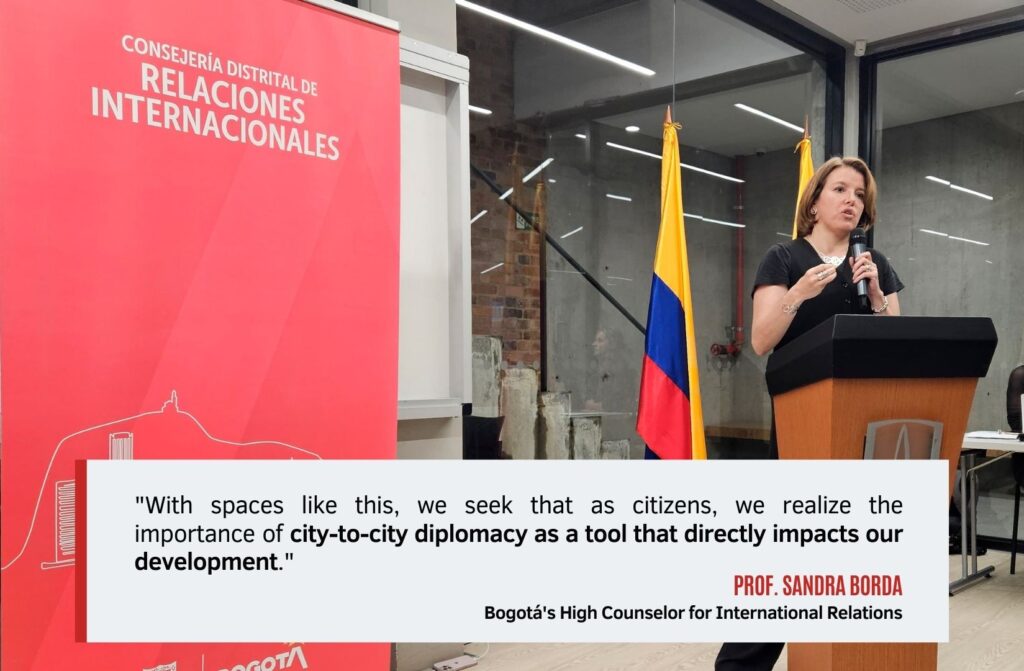
The meeting was divided into two panels, each dedicated to identifying the nature, opportunities, and challenges of city diplomacy today and discussing its possible future evolution.
🟡🔴#Hoy es nuestro encuentro: 'Internacionalización de las Ciudades: Estrategias y desafíos para el futuro’.
— Relaciones Internacionales Bogotá (@BogotaInter_nal) May 16, 2024
Un espacio para dialogar sobre la importancia de la diplomacia urbana como herramienta estratégica para la colaboración y el progreso de las ciudades a nivel global. pic.twitter.com/B1LQ34oUiHThe first panel highlighted the growing evidence of city diplomacy as an impactful multistakeholder process. Cristina Zambrano Restrepo, Executive Director of the Medellín Cooperation and Investment Agency, emphasized how “Internationalization has allowed us to transform our image. It was a collaborative effort involving academia, the private sector, and the public sector to change the previously negative image.”
Also central to the discussion was the strategic importance of multilevel cooperation in international relations. According to Sohaela Amiri, Senior Research Officer at the USC Center on Public Diplomacy, domestic and international politics cannot be understood separately. In this regard, Max Bouchet, City Diplomacy Lab Associate Fellow and Deputy Director for City and State Diplomacy at the Truman Center for National Policy, emphasized the importance of cities’ pedagogical role vis-à-vis their national government concerning city diplomacy.
The panelists also paid great attention to the role, spaces, and recognition of cities’ actions in global governance. According to Buenos Aires Undersecretary for International Relations Ana Ciuti, despite the great progress made by major cities around the world in their internationalization processes, there is still much to be done: “There are global challenges that have a direct impact on us as citizens. For this reason, cities need to open up more spaces in global decision-making bodies.”
The panel also included a focus on city diplomacy risks. Rodrigo Perpetuo, Executive Secretary of ICLEI South America, emphasized the importance of a strategic perspective on the part of cities in order to avoid the potentially distorting effect of conducting city diplomacy as a mere reaction to external stimuli.
In the second panel, City Diplomacy Lab Director Lorenzo Kihlgren Grandi provided insight into cities’ unfolding opportunities to pursue their global impact ambitions within multigovernmental processes such as COPs and the UNECE Forum of Mayors. He also emphasized how the city diplomat profession is evolving to cope with its expanding responsibilities.
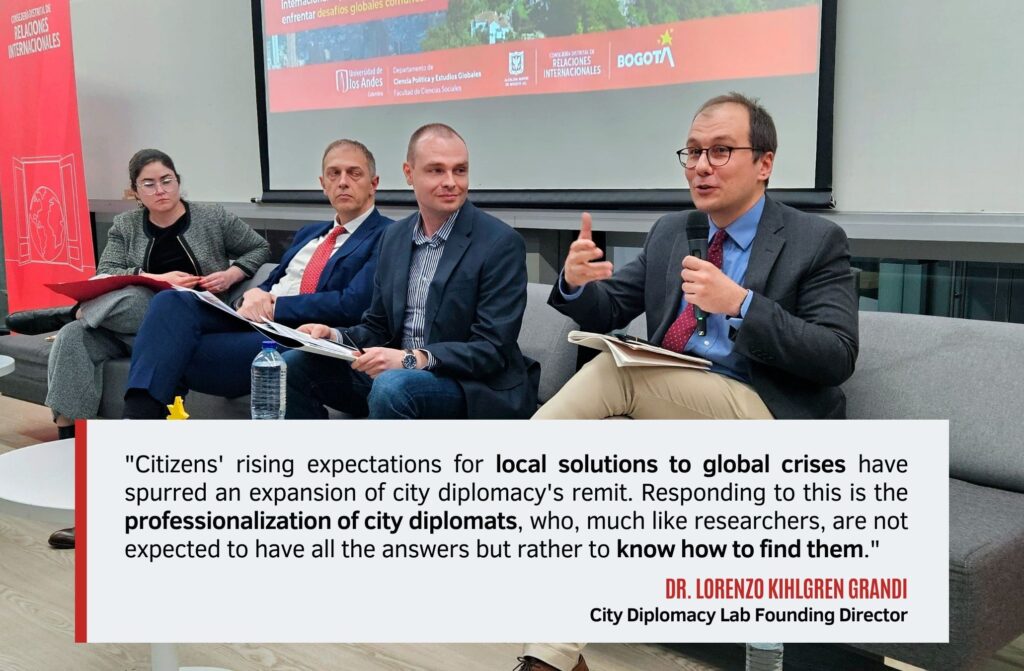
The panel provided insight into the role of mayors as advocates for global social agendas and agents of political discourse. “They see internationalization as more than pragmatic aid or access to international resources,” stressed Jordi Vaquer, the Secretary General of the Metropolis. U.S. State Department’s Subnational Diplomacy Unit Adviser Natalia Cote-Muñoz linked this expanded role to the process of urbanization: “The accelerated process of urbanization has increased the role of cities in global issues. Many global problems are local and are very similar regardless of country.” Raffaele Marchetti, Vice Provost for Internationalization at LUISS University in Rome, emphasized the rising costs for cities that choose not to internationalize.
Counselor Borda concluded the event by stressing the importance of collective and participatory work to achieve internationalization processes that involve and engage citizens. “It is from the local level that citizens’ trust is recovered. Hence, it is important to see internationalization within an identity framework to collectively understand and build what we want to show the world and how we recognize ourselves,” she remarked.
For more information on Bogotá’s international action, visit this page.
-
City diplomacy after dark: urban networks for better cities at night

Cities have been planned for centuries to be fully operational during the day, but several activities take place in cities between 6 pm and 6 am. Services such as waste collection and management of green areas, logistics of goods, healthcare, and public transport often operate around the clock, with a considerable impact on the urban fabric in addition to the sectors that are traditionally recognized as part of the night-time economy, such as bars, restaurants, clubs, and music venues. 1 out of 15 workers in North America and 1 out of 9 workers in Australia work at night-time, while the night-time economy supports 723,000 jobs in London.
Reshaping how cities function at night to improve services and public spaces for a better quality of life for the residents is a global challenge. Across the globe, more than 100 cities are creating night policies aimed at enhancing the impact of night-time activities for developing new forms of environmental, economic, and social development.
At the same time, night policies are fostering a balance among the needs of different categories of residents, acting on a series of challenges such as the promotion of business and cultural vibrancy, the connection between night-time economy and tourism attractiveness, the creative reuse of public spaces and green areas at night in times of climate emergency, the contrast to noise pollution and the extension of public services after dark, such as public libraries, nurseries, and urban mobility systems.
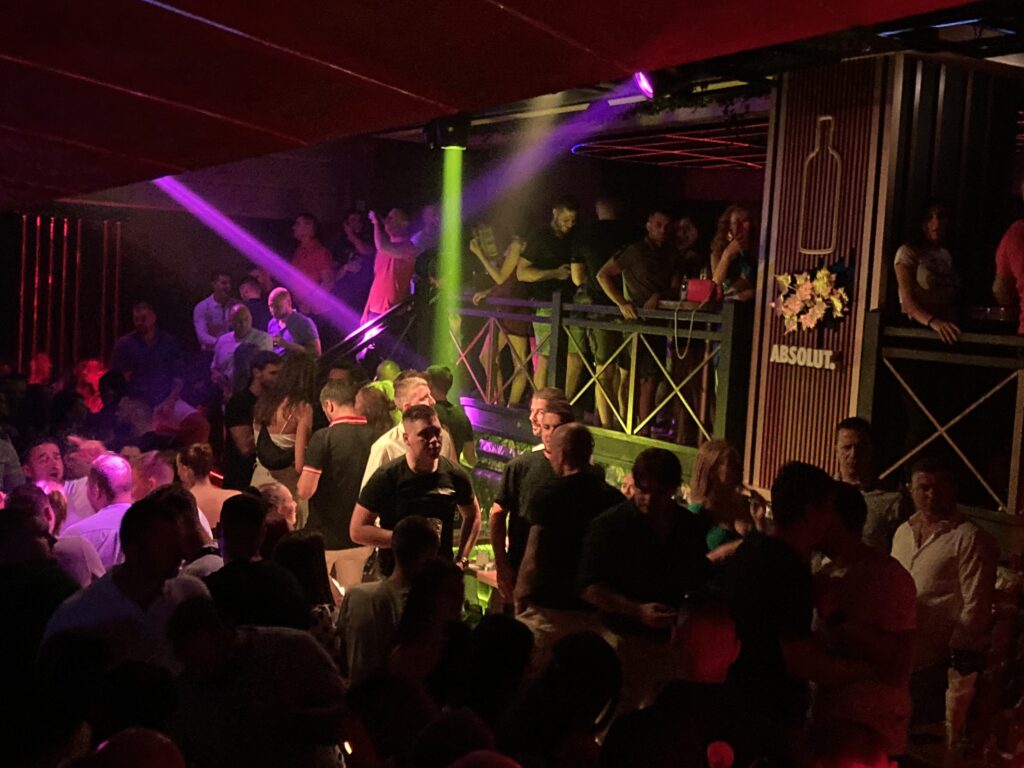
Bars and clubs are some of the venues traditionally associated with the night-time economy, as in the case of Budva – Credits: Simone d’Antonio Governing the night after the emergency
The collaboration among local governments on night-time policies is particularly important for supporting the long-term recovery of some of the sectors more strongly affected by the consequences of the COVID-19 pandemic. The pandemic had a devasting impact on the night-time economy, with a high number of clubs and music venues that struggled to reopen and night services that were canceled or strongly reduced. However, a global debate on night-time recovery after COVID-19 led many local authorities around the world to reflect on the impact of the sector on local economies and on city attractiveness. Safely reopening bars, clubs, and cultural venues was the priority, but some habits that emerged after the pandemic, such as a stronger use of outdoor spaces, are positively kept but need to be effectively managed to improve the quality of life in cities and guarantee the right to the city at night for all.
The need for more integrated governance of the challenges related to the night-time economy was revamped in many cities across the globe. Local governments appointed night mayors or created night commissions, following the example of cities such as Amsterdam, Berlin, Zurich and San Francisco that consolidated these forms of governance by the beginning of the 2000s, while other cities created night-time economy offices which fostered the coordination among different departments with policies having a direct impact on the night-time.
Many local authorities appointed deputy mayors or councilors with thematic competencies on night issues, reinforcing the collaboration with the mayor’s offices or with public safety, economic development, or cultural policies. Stronger ownership of the night-time challenges also led to the recognition of the clubbing culture as part of the cultural landscape in Berlin and to the creation of initiatives such as funding schemes for supporting the cultural vibrancy of music venues in Tallinn or the installation of soundproof systems in night venues in Paris.
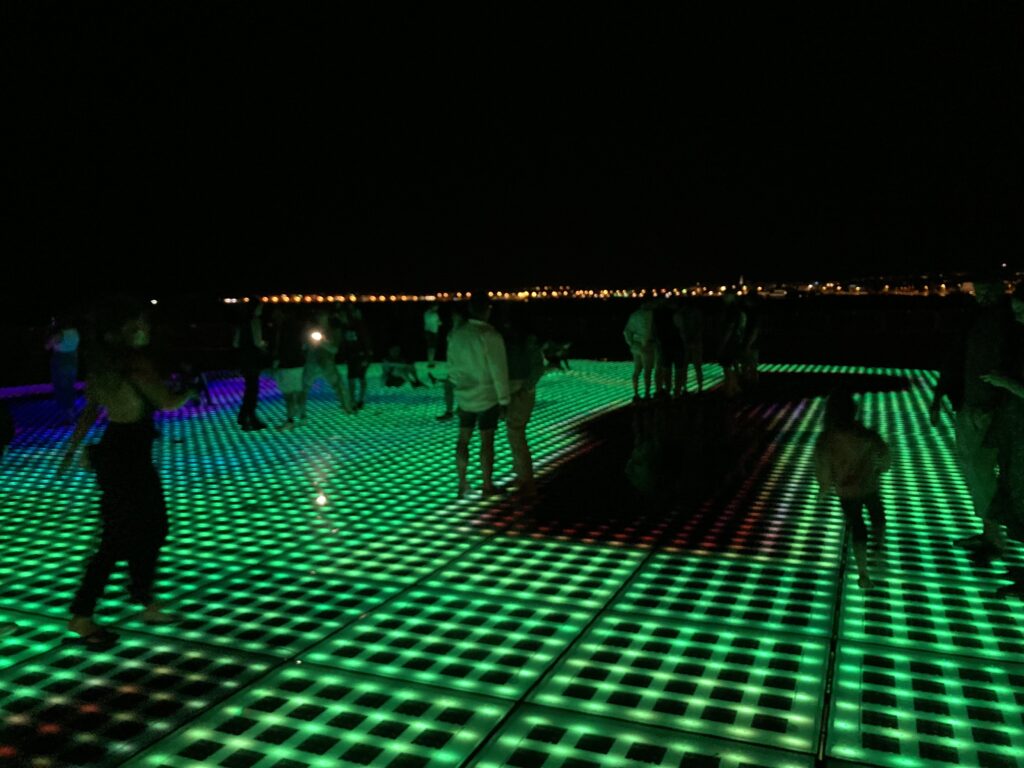
Innovative lighting systems can improve the use of public spaces and the perception of safety at night, as is happening in Zadar – Credits: Simone d’Antonio The urban networks on night-time economy
Even though the night-time economy is an emerging field in the urban debate across the globe, there are still not so many urban networks or collaborative projects fostering the dialogue among local authorities on the topic. One of these few is Cities After Dark, the first EU co-funded network promoted by the URBACT program, which is fostering the creation of integrated action plans in 10 European cities that are exploring the different dimensions of urbanity at night.
Led by Braga and having Paris, Tallinn, Nicosia, Genoa, Malaga, Varna, Piraeus, Budva, and Zadar as partners, the network is spreading a stronger awareness of the role played by cultural venues, clubs, and other night hubs for the quality of life of the inhabitants and for the future of cities, which can regenerate unused spaces and structures also rethinking the operational hours and the connection with other urban services and infrastructures. This diverse group of cities comprises urban contexts with different experiences in the night-time economy but is united by the commitment to making the night an open laboratory for experimenting with innovative functions that can improve how cities operate on a 24/7 basis, leaving no one behind.
Elements such as the promotion of gender equality and the access of women and minority groups to better jobs at night recall a series of challenges that need to be tackled acting on several dimensions at urban level, from the redesign of public spaces and public lighting systems to the accessibility of public transport and the safety of cultural and entertainment venues.
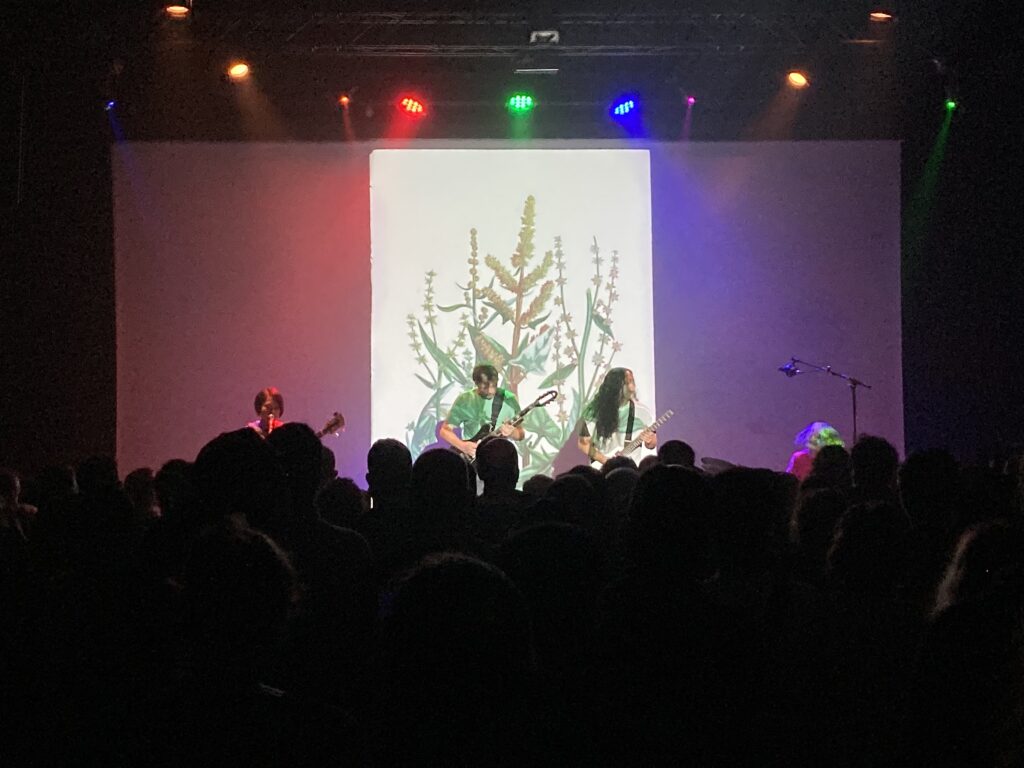
Music venues such as the Gnration in Braga are decisive for improving the quality of the cultural offer at night – Credits: Simone d’Antonio The role of city diplomacy in making cities better at night
City diplomacy can be a powerful ally for making cities better at night. The dialogue among city representatives, experts, and night activists organized at the occasion of the last UN Habitat’s World Urban Forum of Katowice and fuelled by the Safer Cities Programme is an interesting example of how global forums can spark the conversation on a topic that is crucial for the future of cities. Consultancy agencies are acting as a point of reference for night mayors, experts, and practitioners across the globe, while major events such as the Montreal Night Summit MTL 24/24 are fostering collaboration among night-time managers and experts from America and the rest of the world.
City diplomacy can also be decisive for popularizing the discourse over the potential of the night as a testing ground for innovative actions in the cities of the Global South, where thematic policies or integrated forms of governance of the night-time economy are less present than in the rest of the world. The analysis of different night strategies, action plans, and integrated forms of governance is an important step for raising awareness on a topic such as the night-time economy, which has been rooted in the tradition of numerous countries (for example, with night markets or other forms of public life and celebration after dark) but can still act as a driver for growth with activities fostering not only economic and cultural vibrancy but also safety and community spirit.
Simone d’Antonio
City Diplomacy Lab Associate Fellow & URBACT Lead Expert – Cities After Dark
Author of the Cities After Dark Baseline Study and Network Roadmap
Header image: the partners of the URBACT network Cities After Dark at the Machine du Moulin Rouge, at the occasion of the Transnational Meeting of Paris in February 2024 – Credits: Simone d’Antonio
-
Interview with Rosine Pema Sanga, New Orleans’ Head City Diplomat
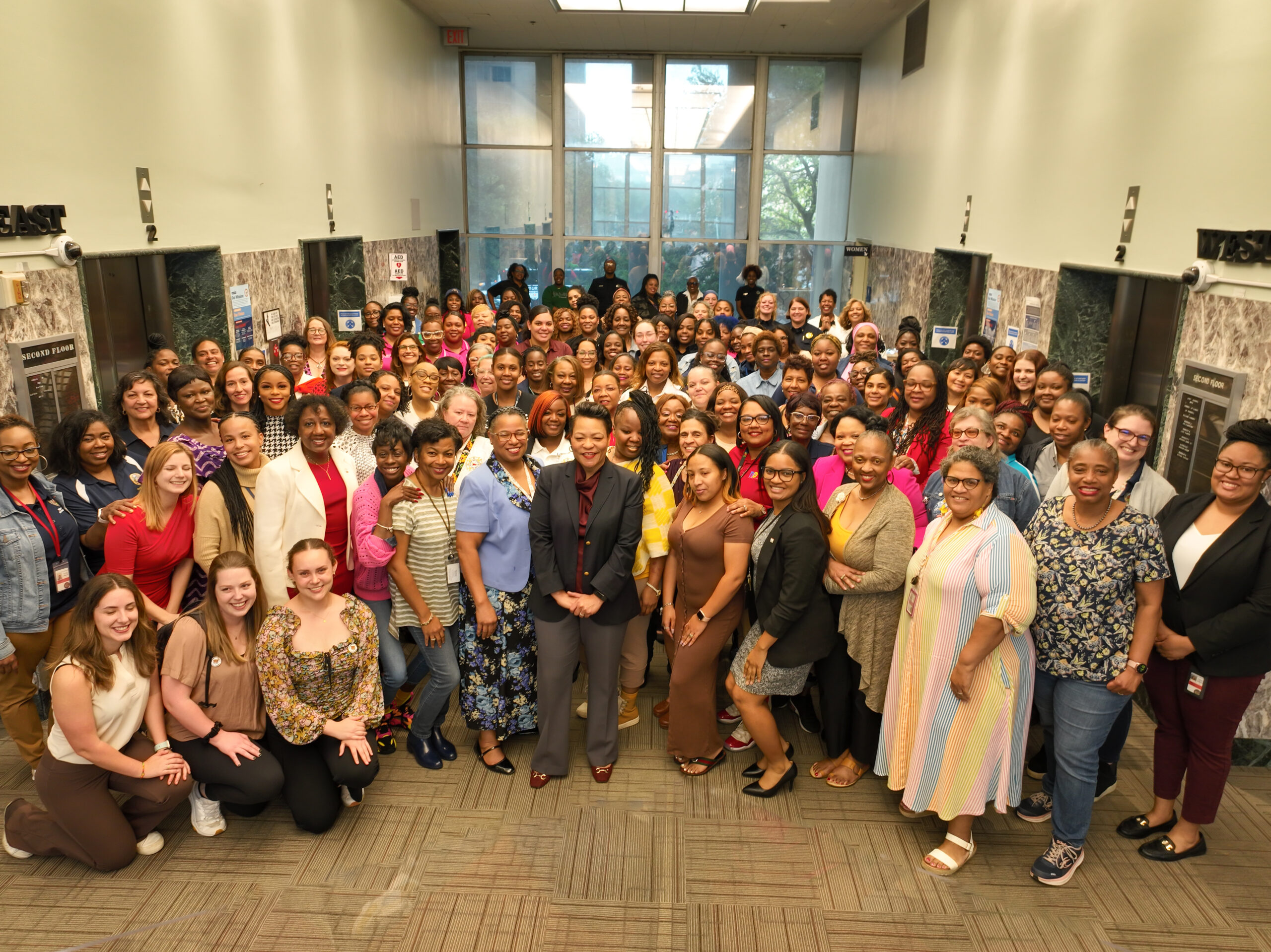
What path led you to become a city diplomat?
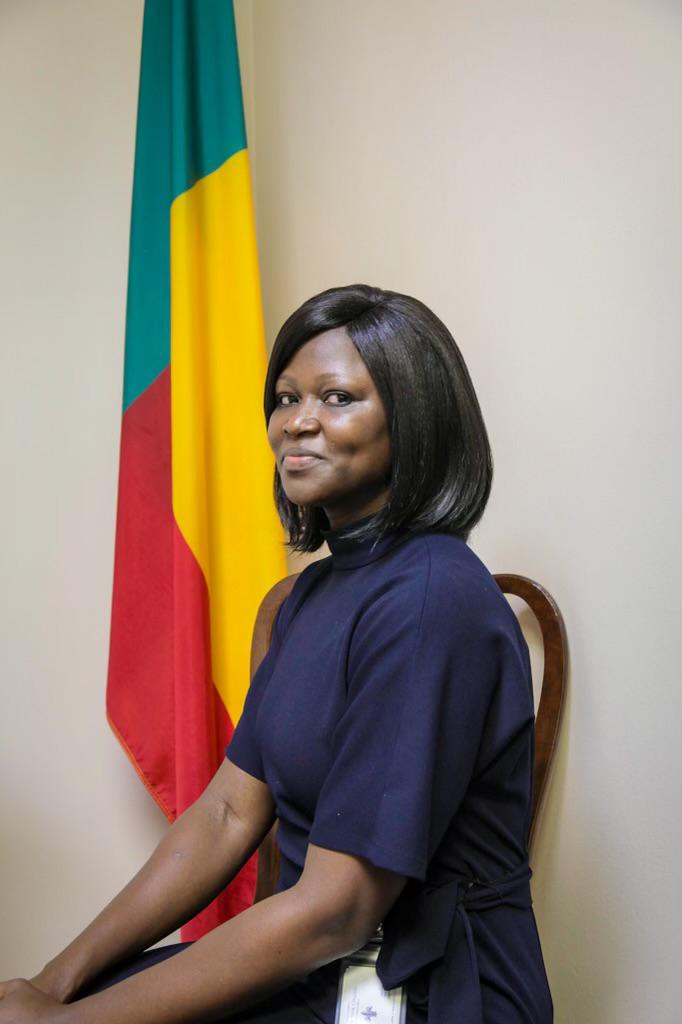
My experience as an international student from Toucountouna, Benin, to New Orleans, Louisiana, in the United States of America is what led me to become a City Diplomat. In 2007, I moved to New Orleans to pursue my education, starting with learning English as a Second Language at the Intensive English Language Program at the University of New Orleans (UNO). During that time, I met Mrs. LaToya Cantrell, then President of the Broadmoor Improvement Association, who was meeting with leaders from various African countries.
I assisted Mrs. Cantrell with the visitors and loved interacting with them. In December 2012, I obtained my Bachelor of Arts in International Studies from UNO and was hired as the Executive Assistant of Councilmember LaToya Cantrell after she had been elected to District “B” in November 2012. Councilmember Cantrell has long believed in meeting people where they are and wanted to serve everyone in her district, including non-English speakers. In addition to English, I also speak French and Spanish, which was and continues to serve as a benefit when serving the city’s diverse population. While employed in this role, I continued to work with international visitors who met with Councilmember Cantrell from the New Orleans Citizen Diplomacy Council, the current Global New Orleans, through the United States Department of States International Visitor Leadership Program. Whenever I met with any of the groups and spoke to them in their own language, the visitors’ faces would light up as they exclaimed, “Wow, you speak our language!” They were always excited to meet someone who spoke their language. The reactions were priceless, and I loved it. Councilmember Cantrell also loved these meetings, and my passion for serving our people both locally and internationally grew from there. Even though I studied International Studies, I did not think I would ever find myself in this position. I knew I wanted to be a diplomat but did not foresee it happening locally.
What was the most complex challenge you faced as head of New Orleans’ international relations unit, and how did you deal with it?
The challenges that I faced as the Director of International Relations of the City of New Orleans stemmed from being a young Black woman from another country. It is already challenging enough to be a Black woman because you are never considered “enough” or equal to others, but also add to that being young and from another country really heightens the challenge. But I wouldn’t change any of that about me because that is what makes Rosine PEMA SANGA a proud daughter of my late parents. One example of the challenges as a young black woman from another country took place two weeks after I started my job. The Mayor was scheduled to give remarks at an event, and I was to go with her. That morning, I was informed she would no longer attend, and I would need to represent her and speak on her behalf. When I arrived at the event, I overheard people talking about the Mayor and Councilmember canceling their attendance, and both were sending representatives. The young Black woman in me wondered whether I should introduce myself. I walked away at first and came back to introduce myself as if I just arrived. I walked away again after they handed me the program. I felt their disappointment because I was not the Mayor. Moreover, I was a young Black woman. They didn’t know what I could do. When the event started, it was my turn to address the public on behalf of the Mayor.
Facing intimidation, I remembered who I was representing and what she would have done if she had been there. I did not have to deal with it in any way other than getting my job done. I gave my remarks in English and transitioned into the audience’s native language. Everyone was shocked. No one expected me to be able to speak with confidence and to address them in their native tongue. Now, we have a better working relationship, and they are always looking forward to having me at their events. I treasured that moment because of the reaction before and after my remarks. I reflect on it often, and it helps me grow.
There is something I learned from my pastor in 2007 when I was still learning English – while preaching, he would say never allow anyone to take your joy away. Though my English was not great, I managed to understand that, and I made that phrase my own. I wake up every morning with a purpose: to accomplish the task that the Mayor entrusted me with and serve the community who depend on me. The communities I serve are proud to have me, and I am proud of what I have accomplished with all our partners.
What is the most treasured moment in your city diplomacy career?
Every moment that I am serving the Office of International Relations for the City of New Orleans is a treasured moment for me. I love my job; it truly is a passion, and I believe I have the best job. I am grateful to Mayor LaToya Cantrell for awarding me the opportunity to work with people from all over the world. Through my work, I have welcomed people from other countries, from our Sister Cities, as well as traveled to different countries as part of my official duties. I have represented the Mayor numerous times in various countries at various events, including the International Association of Francophone Mayors’ Annual Summit, which I am always looking forward to attending every year. I also get the pleasure of conversing and sharing my work with international dignitaries and guests brought to me by Global New Orleans through the United States Department of States International Visitor Leadership Program. We invited President Emmanuel Macron of France in March 2020, shortly before the COVID-19 pandemic, and we were graced with his visit to New Orleans in December 2022. I was proud to be part of the planning committee, even standing by his plane late at night waiting for his departure. All these moments are treasured.
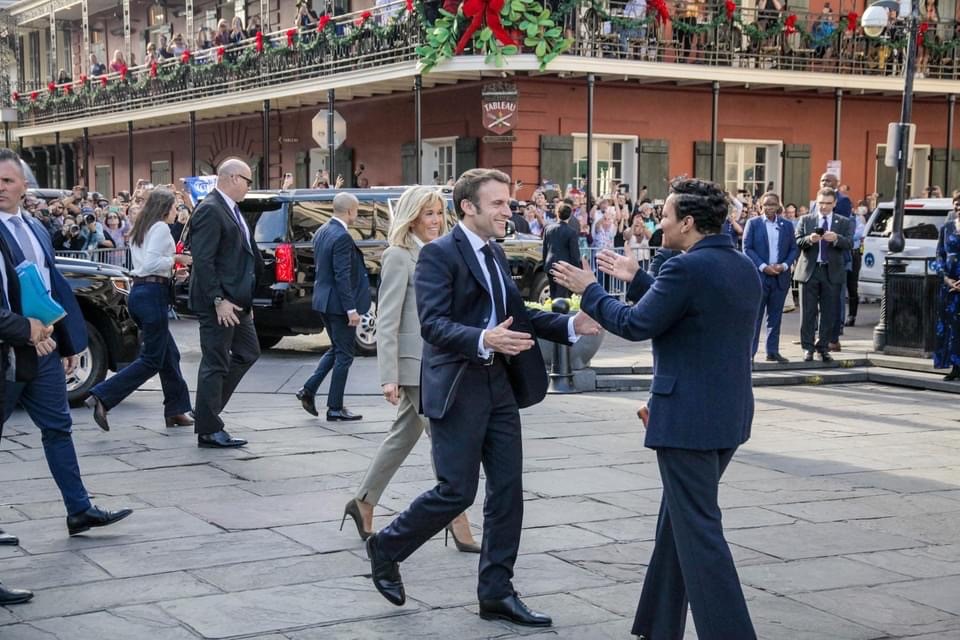
I do want to mention one moment: this occurred this past March 8, 2024, on International Women’s Rights Day. I grew up watching my mother lead women’s associations and organize International Women’s Rights Day events. After I moved to New Orleans, every year at the end of January, I would talk to my mother as she started planning for March 8. In 2015, I lost my mother. Since then, from the end of January until March 8, I have always remembered my mother because she would be planning and talking about International Women’s Rights Day. When I began working here, I always wanted to initiate International Women’s Rights Day, but I lacked the (wo)manpower.
Finally, this year, with the help of certain colleagues, we were able to gather over 150 women for International Women’s Rights Day. It was raining, but women came from different departments looking forward to taking a picture to commemorate that day. It allowed me to understand that many women wanted that event, and we look forward to a bigger and better International Women’s Rights Day in 2025. Even with the weather forecast and short notice, many people showed up and were interested in seeing more. I will never forget that day.
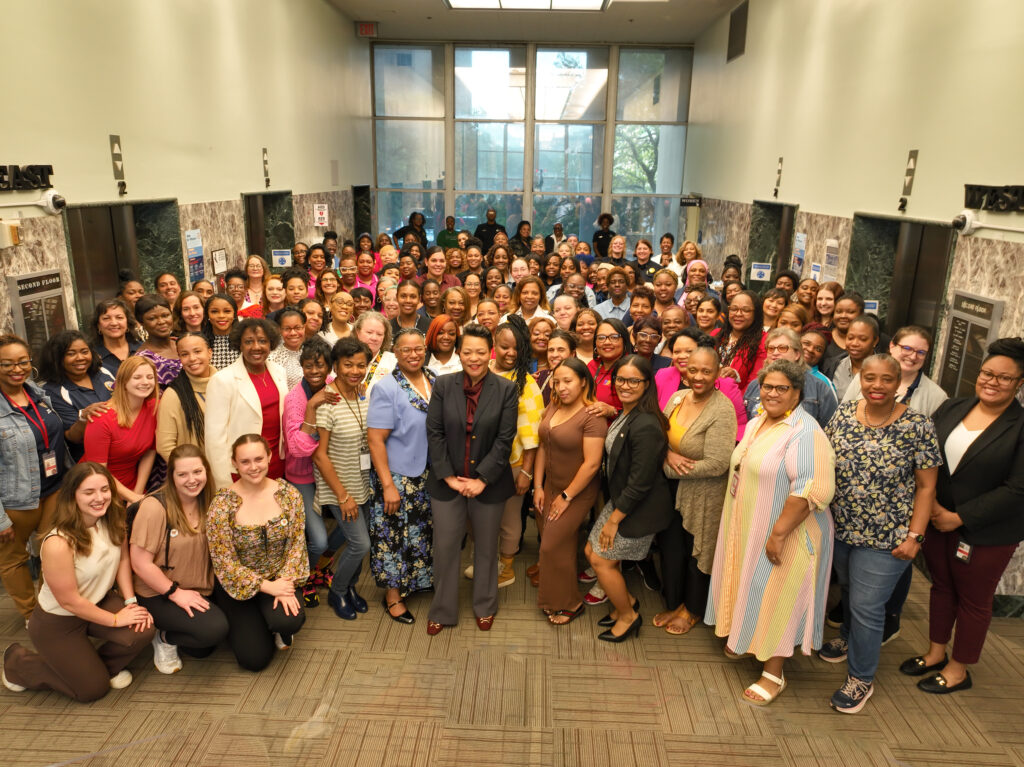
When my mother visited New Orleans in 2008, one of the first English words she learned was “crazy,” so she could tell people her Rosine was crazy. That day, I could hear my mom telling the crowd that Rosine was crazy, and it always made me smile because I knew it was her way of telling people Rosine was my daughter, and I loved her.
In your opinion, how will the work of city diplomats evolve in the coming years?
I am unsure how the work of city diplomats will evolve in the coming years because this depends on future administrations’ willingness to commit to the program. The last time the City of New Orleans had an office of International Relations was at least ten years before Mayor Cantrell. If International Affairs were not a priority for Mayor LaToya Cantrell’s administration, we would not be having this conversation. However, for the past five years that I have been in this role, I believe cities like ours, meaning world-class and internationally recognized cities, deserve a fully functional Office of International Affairs/Relations. The city has almost 50 Consular Corps members, though many of them are honorary. I believe it is essential for a city diplomat to always be a part of any administration because our work aligns with the country’s interests in terms of the country’s foreign policy, and it allows us to maintain our relationships and cultivate new ones across the globe.
What advice would you offer those wanting to pursue a career as a city diplomat?
City Diplomat positions are limited. When Mayor Cantrell’s administration ends, the next administration might not be interested in having this office. The advice I would offer those wanting to pursue a career as a city diplomat would be to prepare to be a “diplomat,” not just a city diplomat. Always be yourself and relate to other people. Accept people and their culture as they are. Learn from other people and their culture, and do not judge those who do not speak the same language as us because they already know their own language and probably speak many others. Overall, always treat people the same way you want to be treated, with respect and dignity.
-
Fostering sustainable construction in informal urban areas
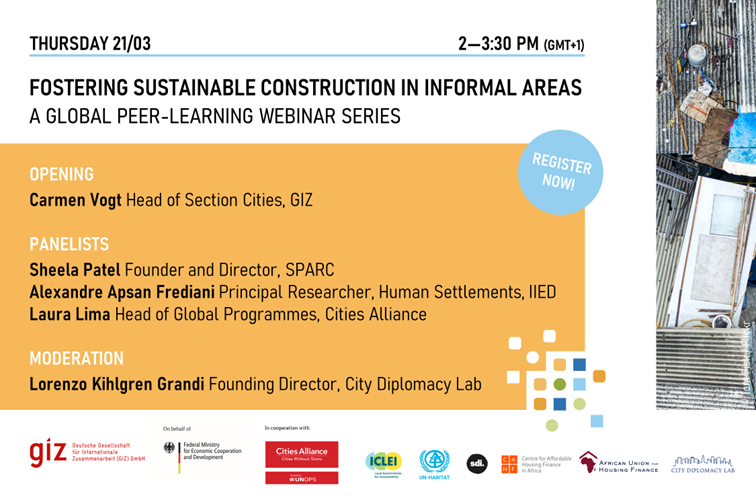
How can living conditions in informal settlements be improved while tackling climate change and urbanization challenges?
Explore inspiring solutions to this urgent challenge by joining our March 21 peer learning webinar on Fostering sustainable construction in informal urban areas.
This is the first episode of the Urban Innovation to Achieve Just & Sustainable Cities series co-organized by Deutsche Gesellschaft für Internationale Zusammenarbeit (GIZ), Cities Alliance, UN-Habitat, ICLEI, Slum Dwellers International, the Centre for Affordable Housing Finance, the African Union for Housing Finance, and the City Diplomacy Lab.
This peer-learning series brings together a diverse group of experts and practitioners to engage in constructive dialogue on the development of sustainable urban planning, construction, and financing strategies for cities across the globe.
Panelists:
- Sheela Patel, Chair of Campaign For ROOH and Director of Society for the Promotion of Area Resource Centers (SPARC)
- Alexandre Apsan Frediani, Principal Researcher, Human Settlements Group, International Institute for Environment and Development (IIED)
- Arne Georg Janssen, Urban Environment Lead, Cities Alliance
Moderation by Lorenzo Kihlgren Grandi, City Diplomacy Lab Founding Director.
🗓 Thursday, March 21, 2024, 9:00 a.m. EDT | 2:00 p.m. CET.
🗣 Language: English, with simultaneous interpretation in Spanish and French.
Watch the recording
-
Decolonizing relations between European and African cities

Interview with Niccolò Milanese, co-curator of the Rhizome Cities project, which empowers European cities’ management of persisting colonial legacies, migration, and diversity.
Q: Your network engages African and European cities in a discussion about the synergies between intercultural and decolonization approaches. How did this concept come about, and how were you able to make it a reality?
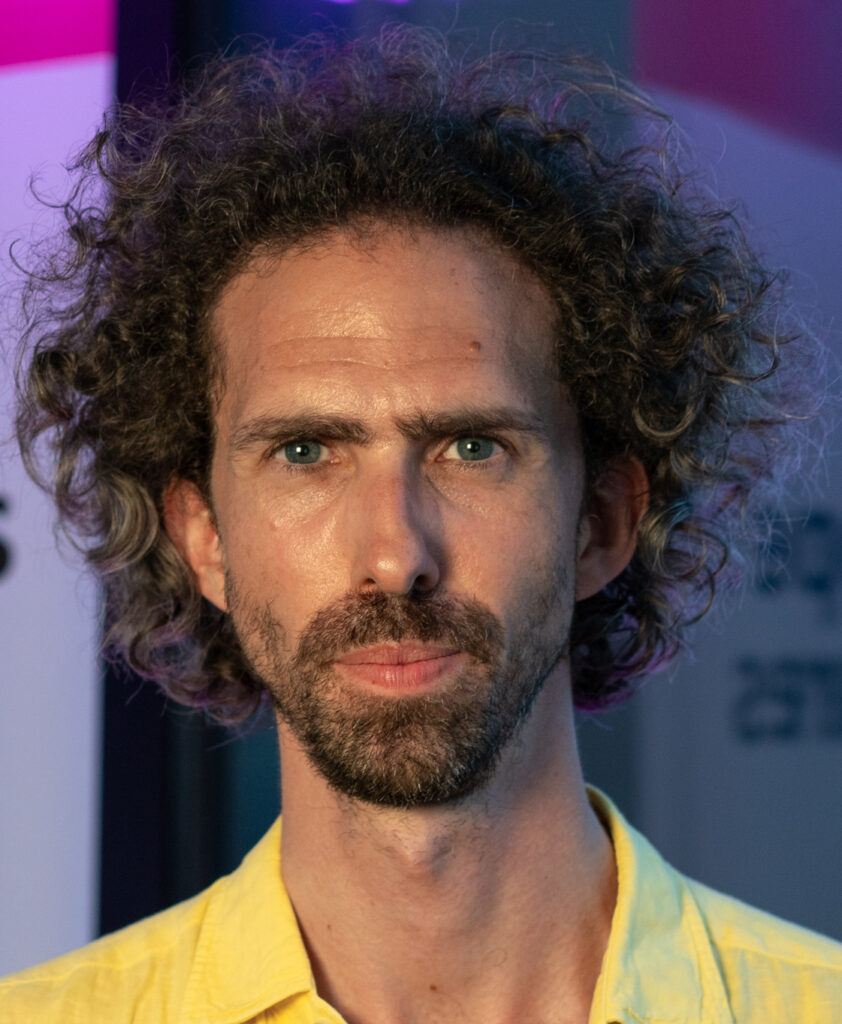
A: Over recent years, city administrations have been challenged by decolonial demands and actions coming from their citizens. Whether this has taken the form of questioning street names or taking down statutes, controversies over the way history is taught in schools, or artworks presented in museums, or even questioning partnerships with other cities in moments of geopolitical tension, city municipalities both in Europe and in Africa have had to deal with strong demands in ways they may be unprepared for.
And whilst the movement of people always has a geopolitical element to it, in recent years, geopolitics has become more conflictual, and these conflicts have an impact on the ways different groups interrelate. Of course, every city has a different experience, every municipal administration a different set of priorities, and so a crucial part of building the network was to be as responsive as possible to welcoming the different ways that each city wants to approach the topics whilst constantly finding the commonalities and underlying issues. This is why the network is called Rhizome Cities: it is both a rhizomatic network and one with a rhizomatic method. We see migration as a normal aspect of city life and develop an approach to migration and movement that is networked across cities, and that is as much about the journeys in between them as any one place.
Q: Rhizome Cities emphasizes inclusive, participatory processes for co-creating urban solutions. What are the added values of involving migrants in such processes?
A: People who move and people with diverse backgrounds are part of our urban settings. Urbanisation is by definition a process of people moving. So it is crucial not to exclude people with a background of movement when designing urban solutions: in fact, by ignoring them, it is the municipal administration that is cutting itself off from the reality of the city – the people living there make the city, whether the municipality wants to pay attention to them or not. So the question is how to bring about the co-creation of the city in a way that turns diversity and the multiplicity of histories and geographical connections into a source of dynamism that ensures that a city is shaping politically and culturally a process of constant reinvention and is not passively being shaped by external forces or private interests.
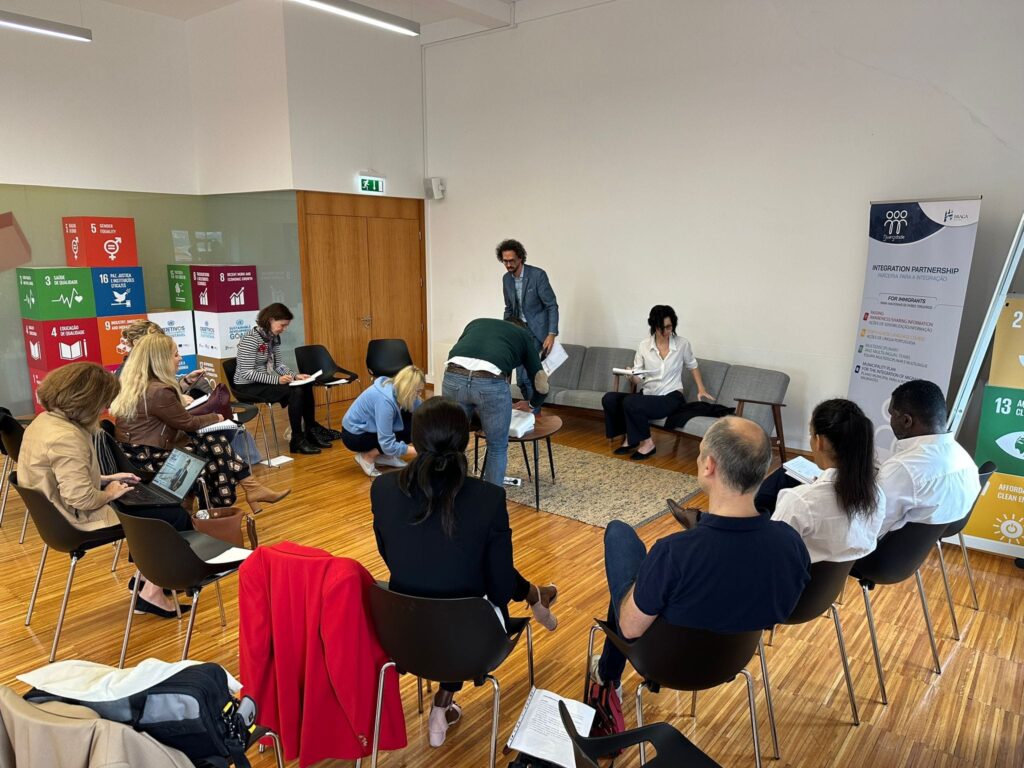
Rhizome Cities – Workshop in Braga, Portugal, 2023 Q: Your cities engage in peer learning and knowledge exchange. Can you give us some examples of best practices that have been transferred within the network?
A: Athens trained migrants to be tour guides of the city, giving a different intercultural perspective on one of the most symbolic cities in the world; anti-rumor and antidiscrimination campaigns of the municipality of Braga were very important during the Covid-19 pandemic to reduce intercultural tensions; Montpellier showed excellent practices of providing literacy and numeracy to recently arrived migrants; Marseille examples from their museums of how objects have migrant journeys like people; and Bergamo examples of school education in interculturality by students becoming aware of their own frame of reference and how that might different to other people. In each of these examples, what was striking was that the municipality often had to work across different departments and government services and include migrant populations themselves in the design and delivery of the practice.
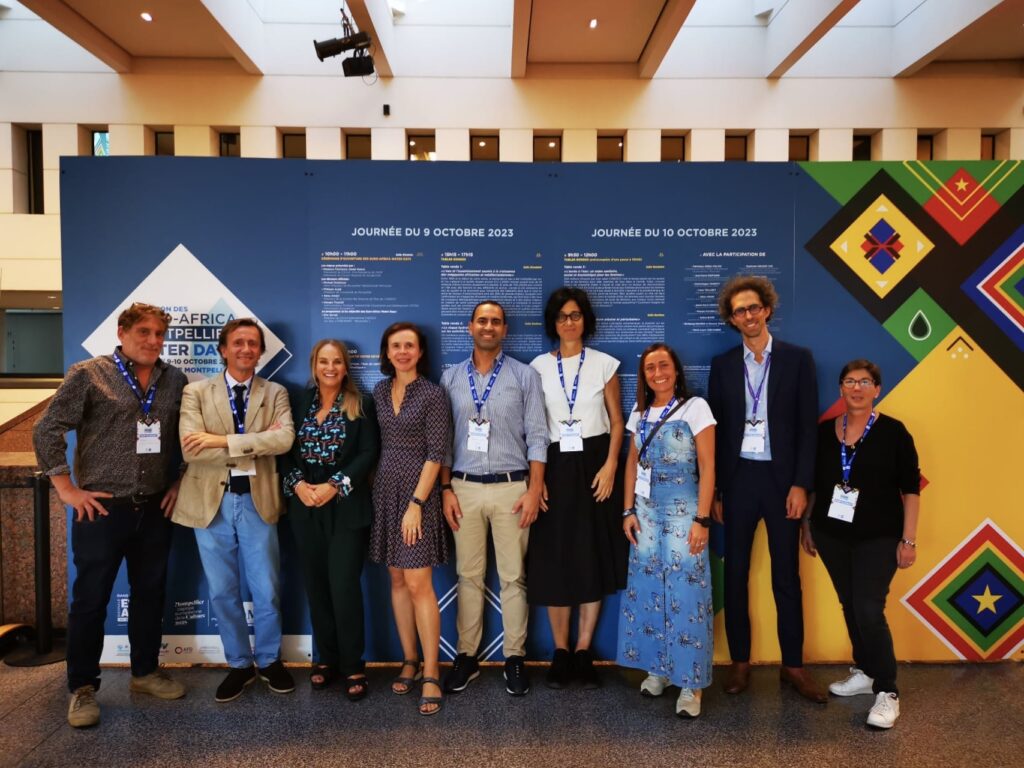
Rhizome Cities at the 2023 Euro-Africa Water Days in Montpellier Q: At the 2023 Montpellier Water Days, you presented the Rizoma Cities Mayors Declaration. What is the expected impact of that text on the future of the network?
A: We see the Declaration as the closing of the first pilot phase of the Rhizome Cities network and the first moment of the consolidation and expansion of it. We already have the interest of many more cities to participate in the next round of meetings that will develop communities of practice around specific interests, foresee targeted forms of engagement for city actors who are not elected or administrative officials, and will elaborate in more detail our unique approach which integrates culture, education, social services, urban planning, economic development and international relations of a city in its approach to diversity.
